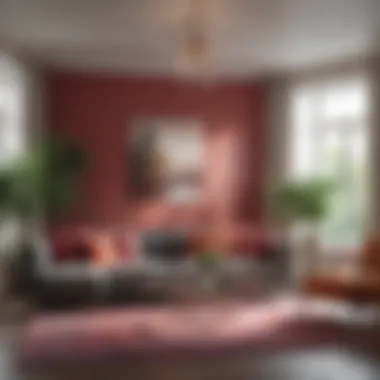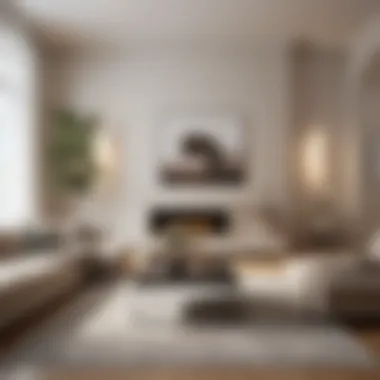Exploring Modern Colour Schemes for Living Rooms


Intro
Color plays a significant role in shaping spaces. For living rooms, the choice of color can transform not only the aesthetics but also the mood. Understanding modern color schemes is crucial for homeowners looking to enhance their living areas. Contemporary trends in color are influenced by various factors, from lifestyle preferences to environmental consciousness.
Key Insights and Trends
Current Trends in Interior Design
Recent years have seen a shift towards natural and muted tones. Warm neutrals such as beige and taupe are popular. These colors create a calming atmosphere. Many homeowners also choose earthy greens and soft blues. These hues evoke a connection with nature, helping to create a serene environment.
Minimalism has influenced color choices too. Soft pastels are popular as they offer a fresh look without overwhelming the senses. Color blocking is another trend noticed in modern homes. This technique involves using two or more contrasting colors in one room, allowing for a unique expression of style.
Popular Colour Schemes
- Monochromatic: This scheme uses variations of a single color. It can create a sophisticated and cohesive look.
- Analogous: This scheme combines colors that are next to each other on the color wheel. For example, combining shades of blue and green offers a harmonious feel.
- Complementary: This scheme uses opposing colors. It is more daring and can energize the space. For instance, pairing blue with orange.
- Neutral Palettes: Grey, white, and beige are classic neutrals. They are versatile for any decor style whether minimalist or traditional.
Colors can profoundly affect mood and perception. Choosing the right scheme is essential for creating a living atmosphere that reflects personal style.
Practical Tips and How-To Guides
Step-by-Step Guide for Choosing a Palette
- Assess Your Space: Look at the size and lighting of your living room. Natural light can change how colors appear.
- Define Your Style: Consider whether you prefer modern, rustic, or eclectic designs. Your color scheme should reflect your personal taste.
- Select a Base Color: Start with one color you love. Use it as a base for your scheme.
- Choose Complementary Colors: Pick one or two complementary colors. Ensure they align with the mood you want to create.
- Test Samples: Always test paint samples on your walls. Observe how they look at different times of the day.
- Finalize Your Choices: Once satisfied, make a list of colors and begin decorating.
Entertaining Tips and Planning Checklists
- Consider Color Mood: Think about the emotions you want to create for guests. Soft tones for relaxation, brighter colors for energy.
- Decor Accessories: Use throw pillows, rugs, and art in your chosen colors to bring the scheme together.
- Plan Layout: Arrange furniture to highlight your color choices, allowing your scheme to flow throughout the room.
By understanding modern color schemes, homeowners can effectively design their living spaces to reflect their personalities while creating an inviting atmosphere.
Understanding Colour Theory in Interior Design
Colour theory is a foundational aspect of interior design, serving as a guide for homeowners and design enthusiasts alike. It encompasses the rules and guidelines regarding how colours interact with one another and how they influence human perception and emotion. A solid grasp of colour theory can transform a living space, making it more inviting and aesthetically pleasing. The right combination of colours not only enhances the visual interest of a room but can also alter the mood, creating atmospheres that are calm, energizing, or even romantic. Thus, it becomes essential to understand the principles of colour theory when designing a space.
The Basics of Colour Theory
At its core, colour theory revolves around the colour wheel, which presents the relationship between primary, secondary, and tertiary colours. Primary colours—red, blue, and yellow—are the building blocks of all other colours. Secondary colours arise from mixing primary colours, such as green (blue and yellow) and orange (red and yellow). Tertiary colours come from mixing a primary with a secondary colour, leading to various shades like teal or violet.
Familiarity with the colour wheel allows individuals to create harmonious colour palettes. Complementary colours, which are located opposite each other on the wheel (like blue and orange), provide high contrast and vibrancy. Conversely, analogous colours, which are next to each other (like red, orange, and yellow), offer a more cohesive and serene feel. Understanding these basics helps in making informed decisions for living room designs.
The Psychological Impact of Colour
The effects of colour on mood and behaviour are profound and well-documented. Different colours evoke specific emotions and associations. For instance, blue often inspires feelings of calmness and tranquility, making it a common choice for bedrooms and living areas that aim for relaxation. Yellow, on the other hand, can impart a sense of warmth and cheerfulness but may be overwhelming if overused. Additionally, greens are linked to nature and renewal, providing a refreshing backdrop in any space.
Research indicates that warm tones such as red and orange can stimulate conversation and energy, which might be suitable for social settings. In contrast, cooler tones like blue and green work well for relaxation areas. Recognizing these psychological impacts enables homeowners to create living rooms that not only look good but also feel appropriate for their intended use.
Choosing Complementary Colours
Selecting a complementary colour scheme involves understanding the dynamics of colour interaction. One of the most effective ways to choose a colour palette is to select a dominant colour followed by complementary tones that enhance the overall look. This approach creates visual harmony while retaining interest.
When choosing complementary colours, several elements should be considered:
- Lighting: Natural and artificial light sources can drastically change how colours appear.
- Room Purpose: Think about how the room will be used. A vibrant atmosphere may be excellent for a social area, whereas softer tones might suit a space meant for relaxation.
- Existing Elements: Furniture, artwork, and architectural features may dictate colour choices.
It may be helpful to use samples of potential colours in different types of lighting before making final decisions. This practice ensures that the chosen palette aligns with the intended vision for the living room space.


“Effective colour use in interior design is not only about aesthetics but also about emotional responses and personal expression.”
In summary, understanding colour theory is an essential skill for homeowners and design enthusiasts who wish to create beautiful and functional living spaces. By considering the basics of colour relationships, the psychological effects of colours, and how to choose complementary colours, one can successfully transform any living room into a delightful environment.
Current Trends in Colour Schemes
The exploration of current trends in colour schemes is crucial to understanding modern interior design. Colour is not merely functional; it conveys emotion, enhances aesthetics, and defines space. Homeowners increasingly prioritize colour choices as they seek to create inviting environments. Current trends give insight into how colour can reflect personal style while remaining functional and appealing in various contexts.
Neutral Tones and Their Versatility
Neutral tones have become foundations in many modern living rooms. Shades like beige, gray, and white offer a blank canvas that complements diverse styles. They are adaptable and can easily align with changing trends or personal preferences. One remarkable feature of neutral tones is their ability to create a serene atmosphere. This is beneficial in spaces designed for relaxation and socializing.
Moreover, neutral colours allow for significant flexibility in accessorizing. Statement pieces, such as vibrant throw pillows or artwork, can become focal points against these subdued backgrounds. This compatibility makes neutral tones widely popular among interior designers.
Bold Colours in Modern Design
Bold colours are becoming prominent in contemporary interior design. Saturated hues like navy blue, emerald green, and deep red are often utilized to make statements in living rooms. These colours work effectively to draw attention and create dramatic effects that many homeowners find appealing.
While bold colours can risk overwhelming a space, careful selection and placement can yield stunning results. For instance, a single accent wall painted in a bold hue can introduce excitement while maintaining balance. To achieve a cohesive look, pairing bold colours with more muted tones allows for contrast without chaos. In this way, one can enjoy the vibrancy of bold colours without compromising harmony.
Earthy Shades and Nature-Inspired Palettes
Earth tones, such as terracotta, olive green, and burnt sienna, ground living spaces in the natural world. This approach often reflects a growing awareness of well-being and sustainability in design. Using earthy shades creates a comforting ambience, resonating with natural elements. Such colours often remind individuals of organic forms, inviting warmth and tranquility.
Incorporating nature-inspired palettes encourages a connection between indoor and outdoor spaces. This trend can be particularly beneficial for individuals who appreciate gardening or outdoor living. Combining earthy palettes with plants can further enhance the desired aesthetic. The result is a cohesive environment that fosters relaxation and rejuvenation.
"Trends in colour scheme not only enhance the aesthetic but also affect mood and space perception—selecting the right colours can transform how a room feels and functions."
In summary, understanding current trends in colour schemes is vital for anyone looking to enhance their living spaces. Whether one gravitates toward versatile neutrals, bold statements, or earthy tones, there is a world of possibilities to explore in modern interior design.
Practical Applications of Colour in Living Rooms
Understanding how to effectively apply colour in living rooms can transform the space significantly. This section looks at the various practical applications of colour in interior design, providing insights that can benefit homeowners, enthusiasts, and anyone wanting to enhance their living environment. Key considerations include the selection of focal colours, the role colour plays in defining spaces, and how accessories can be used to incorporate colour effortlessly.
Selecting a Focal Colour
A focal colour serves as a fundamental element in a living room. It primarily captures attention and sets the tone for the rest of the space. Choosing an appropriate focal colour often involves understanding the overall style of the room. For example, a bold red or deep blue can convey a sense of energy and vibrancy, while softer shades like pastel greens or blues tend to create a more serene atmosphere.
Some steps to selecting a focal colour include:
- Identify your primary function: Determine whether the room is for relaxation or social gatherings.
- Consider natural light: Some colours look different depending on the light conditions.
- Explore samples: Always test colours on your walls before making a decision.
The focal colour does not need to be large; it could be the colour of an accent wall or a significant piece of furniture. A well-chosen focal colour can define the aesthetics and inform the palette choices for the entire living space.
Using Colour to Define Spaces
Living rooms often act as multifunctional spaces. They can serve as areas for relaxation, entertainment, or work. Utilizing colour to delineate these functionalities can enhance flow and coherence, while maintaining a sense of order.
Consider the following methods:
- Zoning with colour: Use different colours on walls or furniture to differentiate areas. For instance, a lighter shade can signify a reading nook, while a darker tone might denote a preparation area for social events.
- Flow through transitions: Ensure that adjacent spaces have colours that complement one another. This aids in maintaining a harmonious atmosphere throughout the home.
- Textural aspects: Incorporating texture into the colour scheme can also define spaces. For example, glossy finishes can add vibrancy, while matte tones might create a more tranquil environment.
This approach not only adds visual interest but also enhances the overall functionality of the living area.
Incorporating Colour Through Accessories


Accessories are a simplistic yet effective way to infuse colour into a living room without making drastic changes. Common accessories include cushions, rugs, artwork, and decorative objects. They allow for easy modification of the colour palette and can be replaced as trends and personal preferences evolve.
When incorporating colour through accessories, remember:
- Start small: Introduce one or two colourful accessories to see their impact before committing to more significant changes.
- Balance is key: Aim for a balanced colour distribution throughout the room. This avoids overwhelming the space.
- Seasonal rotation: Consider changing accessories with seasons. Warmer tones may suit autumn, while lighter pastels work well in spring.
Colorful accessories bring energy and personality to the space, reflecting individual style while transforming the living room into a lively and inviting area.
"Engaging colour in living spaces is more than aesthetic pleasure; it can influence mood and functionality of activities within the room."
In summary, the practical applications of colour in living rooms offer numerous benefits. They assist in enhancing moods, defining spaces, and reflecting personal style. By carefully selecting a focal colour, using colour to establish areas, and incorporating accessories, homeowners can create an inviting and functional environment.
Creating Harmony in Colour Schemes
Achieving harmony in colour schemes is central to creating a cohesive living environment. It involves understanding and utilizing colours in a way that they enhance each other and contribute to the overall aesthetic. Harmony in colour can evoke feelings of calmness, warmth, and elegance. When executed properly, it can transform a room from disjointed to inviting.
The Role of Accent Colours
Accent colours serve as the highlight of any colour scheme. They add interest and depth to a space that might otherwise feel flat. By using an accent colour, whether a vibrant hue like teal or a softer shade like blush, you can draw attention to specific elements like cushions, artwork, or furniture pieces. This strategic placement creates visual intrigue and balance.
When selecting an accent colour, consider your base colours. A strong contrast can energize a room, while a subtle variation can maintain a sense of tranquillity. For example, if you have a neutral base of beige, you might choose a deep navy as an accent. This contrast can make the room feel layered without overwhelming it.
Balancing Warm and Cool Tones
Understanding the balance between warm and cool tones is crucial in achieving visual harmony. Warm colours, such as reds and yellows, often evoke energy and activity, while cool colours like blues and greens create a calming atmosphere.
Finding a balance can have a significant impact on the mood of a living room. For instance, too many warm tones can create a restless environment, whereas an overabundance of cool tones might induce feelings of detachment.
A thoughtful mix can incorporate both realms effectively. Consider using warm tones as the main colours, with cooler tones introduced in accents or furniture. This approach can result in a dynamic yet harmonious room that feels both inviting and comfortable.
Achieving Cohesion Across Different Rooms
To create a sense of continuity throughout your living spaces, it is important to achieve cohesion in colour schemes across different rooms. This does not mean every room must be the same, but they should share some common elements.
To ensure cohesion, consider the following:
- Shared Palette: Use a similar colour palette across connected spaces. This may include common hues that are present in both areas.
- Transitional Spaces: Hallways or open areas serve as transitional spaces, making it essential to maintain harmony here. A seamless flow draws the eye and keeps the experience cohesive.
- Key Elements: Include key elements like artwork or furniture that repeat colours or themes throughout the series of rooms.
Strategic planning during the design process can foster a fluid movement between rooms, enhancing the overall sense of home.
Cohesion in colour schemes not only promotes visual appeal but also fosters emotional connections within the space.
By embracing these principles, homeowners can cultivate living rooms that resonate with elegance and serenity, creating a space that feels refined yet personal.
Influence of Lighting on Colour Perception
The way colour is perceived in a living room heavily depends on the lighting conditions present. This concept is essential for anyone looking to create a specific mood or aesthetic in their space. Natural light and artificial light each have unique properties that can influence how colours appear, affecting not only aesthetics but also the emotional response to the environment. Understanding these factors can enhance the overall interior design approach.
Natural Light and Its Effects
Natural light varies throughout the day and can drastically change the appearance of colours in a living room. It is essential to consider the direction of windows and the time of day when selecting a colour palette. For instance, morning light tends to have a cooler tone, while evening light provides a warmer hue. This shifting quality can bring out different aspects of a colour.
In rooms with ample sunlight, shades of blue, green, and yellow may appear brighter and more pronounced, providing a vibrant and lively atmosphere. Conversely, in lower light conditions, these same colours may seem muted or flat. Consider the following implications of natural light:
- Orientation: South-facing rooms receive the most light, creating an environment well-suited for vibrant colours.
- Reflection: Light-coloured walls can reflect more natural light, enhancing brightness in the room.


To optimize the use of natural light, various approaches like using sheer window treatments can facilitate pleasant ambient light while minimizing glare. The key takeaway is that natural light can add depth and dimension to colours, greatly influencing the ambiance of a living space.
Artificial Light Sources: Types and Impacts
Artificial lighting plays a crucial role in how colours are experienced indoors. There are multiple types of artificial light sources, including incandescent, fluorescent, and LED, each affecting colour perception differently.
- Incandescent bulbs: These provide a warm, yellow light that can enhance the richness of reds and yellows, producing a cozy atmosphere. It is suitable for intimate settings but may wash out some cooler tones.
- Fluorescent lights: Known for their sharp and bright white light, these can sometimes distort colours, emphasizing blues and greens at the expense of warmer tones. This could create an unwelcome feeling of starkness.
- LEDs: Offering versatility, LEDs come in various colour temperatures, allowing designers to select lighting that best fits their palette. Warm LED lights can replicate incandescent warmth, while cooler options can provide a modern feel.
Selecting the right artificial light is paramount for achieving the desired aesthetic in a space, ensuring harmony with the chosen colour scheme.
Understanding how different lighting affects colour allows homeowners and design enthusiasts to make informed choices. It is advisable to test samples of paint or fabrics under varied lighting conditions before final decisions are made. Observing how a room's lighting influences its colour scheme can lead to a more harmonious and appealing living area.
Case Studies of Successful Colour Schemes
Examining real-world applications of colour in living rooms provides valuable insights into how theory translates into practice. Case studies reveal effective strategies and inspire creativity. They highlight the effectiveness of chosen palettes, showcase the versatility of different hues, and demonstrate how colour can influence mood and perception within a space. These examples guide homeowners and design enthusiasts in their journey to curate their personal environments, aligning aesthetics with functionality.
Contemporary Minimalist Designs
Minimalism focuses on decluttering and simplicity, often utilizing a restricted colour palette. Here, design choices center on combinations such as white, grey, and muted pastels. This strategy supports a sense of calm and spaciousness. Popular examples include rooms with white walls complemented by soft furnishings in pale grey and subtle touches of darker shades.
The impact of natural light is pivotal in such designs. Large windows allow sunlight to enhance these hues, making the space feel airy and open. Furniture, often in light wood or metal finishes, further emphasizes the minimalist mantra.
Key components in minimalist designs include:
- Clean Lines: Furniture choices that emphasize simplicity and functionality.
- Neutral Colours: The predominant use of whites and greys creates a cohesive look.
- Textural Variety: Incorporating different materials adds depth without cluttering the visual field.
This approach proves how fewer colours can yield a striking effect when curated thoughtfully.
Eclectic Mixing of Textures and Colours
In contrast, an eclectic style embraces a diverse palette. Different textures and colours come together to create a rich and dynamic environment. This style connects various influences, showcasing playful combinations. One might see bold reds paired with deep blues, accented by rich greens. Each piece, whether a vintage chair or contemporary artwork, tells its own story within a united visual narrative.
Considerations for achieving balance include:
- Layered Textures: Combine materials such as velvet, linen, and leather for a tactile experience.
- Complementary Colours: While the palette is diverse, colours should harmoniously align to avoid visual chaos.
- Focal Points: Use standout elements, like a striking painting or an accent wall, to anchor the room.
This design method resonates with individuals who appreciate personal expression. It offers a unique opportunity to showcase interests and personality while engaging the observer.
"The joy of eclectic designs lies in their individuality and the stories they tell through diverse elements."
Through these case studies, one can see the transformative power of colour. Understanding these successful schemes helps individuals to draw inspiration for their own living spaces, tailoring the concepts to reflect personal style while maintaining functional living environments.
Future Trends in Living Room Colour Schemes
Understanding future trends in living room colour schemes is essential for homeowners and interior design enthusiasts. As our world evolves, so do our preferences in aesthetics and functionality. This section explores the significance of emerging trends, emphasizing the elements that can transform a living space. Adapting to these trends not only enhances the visual appeal but can also improve emotional wellbeing and sustainability.
Sustainable and Eco-Friendly Choices
Sustainable and eco-friendly colour choices are rising in popularity. This trend promotes materials and paints that are non-toxic and have a lower impact on the environment. Many consumers are becoming aware of how their design choices affect the planet.
- Natural Paints: These come from plant-based sources and lack harmful chemicals, making them safer for indoor air quality.
- Recycled Materials: Using furniture and decor made from recycled elements not only reduces waste but also provides unique character to the space.
- Energy-Efficient Lighting: Incorporating LED lighting can complement colour choices while lowering energy consumption.
Adopting sustainable practices in interior design reflects a commitment to the environment and supports the well-being of future generations. By choosing eco-friendly alternatives, homeowners can enjoy a chic aesthetic without compromising on principles.
Technological Advances in Colour Application
The integration of technology in colour application has transformed how we approach interior design. Today, tools such as augmented reality and advanced paint formulations allow easier exploration and execution of colour schemes.
- Augmented Reality Apps: These enable users to visualize different colours on their living room walls virtually before making a commitment. This innovative technology allows homeowners to experiment with various palettes without the physical process of painting.
- Smart Paints: Developments in paint technology have led to options that change colour based on lighting or surroundings. This flexibility can create dynamic environments that adapt to different moods and occasions.
- Online Colour Visualizers: Many paint companies offer online platforms where users can upload images of their rooms and apply different colours virtually, helping in decision-making.
Embracing these technological advancements not only enhances creativity but simplifies the design process. Homeowners can effectively experiment with modern colour schemes, ensuring they select the perfect match for their living spaces.
The future of living room design relies on a blend of sustainability and technological innovation, creating spaces that are both beautiful and responsible.



